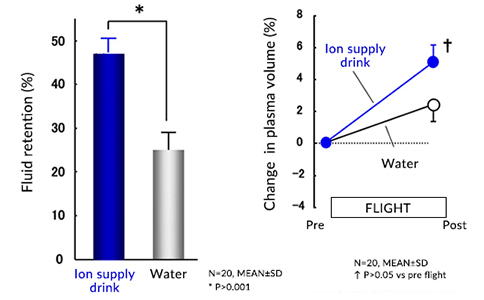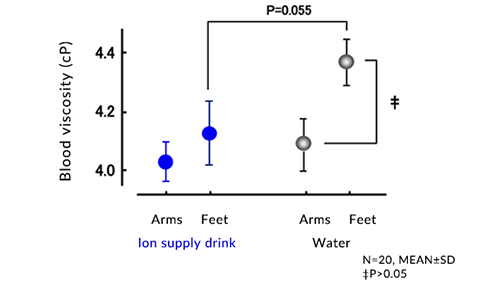Effects of hydration on fluid balance and lower-extremity blood viscosity during long airplane flights
Hamada K, Doi T, Sakurai M, Matsumoto K, Yanagisawa K, Suzuki T, Kikuchi N, Okuda J,
Miyazaki H, Okoshi H, Zeniya M, Asukata I
JAMA 2002; 287: 844-845
Purpose
We studied the hypothesis that an ion supply drink would be more effective at maintaining the hydration and blood viscosity than water on a long distance international flight.
Methods
Forty healthy male subjects were studied during a nine-hour flight. All subjects were randomly assigned to either an ion supply drink (n=20) or water (n=20) group. The subjects drank the respective fluid immediately before take-off (340mL), at two hours after take-off (150mL with a standard meal), at 3.5 hours (340mL), 5.5 hours (150mL with a standard snack) and at 7.5 hours (340mL). After take-off, the subjects remained seated in the coach section except when providing urine samples before each drink of the test solution. Blood samples were collected before and after the flight. Post-flight blood was drawn from the antecubital vein (arms) and the lesser saphenous vein (feet) after landing while subjects were still sitting in the cabin. The body weight was recorded before boarding and after landing. Urine samples were collected every two hours during the flight.
Results
The fluid retention* was significantly higher for subjects who received the ion supply drink. The change in the plasma volume was significantly higher in subjects who consumed the ion supply drink. The blood viscosity in the feet of subjects who received water was significantly higher than that in the arms, whereas no significant difference between the viscosity in the arms and feet was observed in the subjects who received the ion supply drink.
- *Fluid retention (%) = (intake volume of test solution - urine output) / intake volume of test solution × 100
Conclusion
Consumption of an ion supply drink significantly increased the plasma volume compared with water. The increase in the blood viscosity in the feet was less pronounced in the group that received the ion supply drink. The consumption of an ion supply drink may provide better hydration than plain water during long flights.











